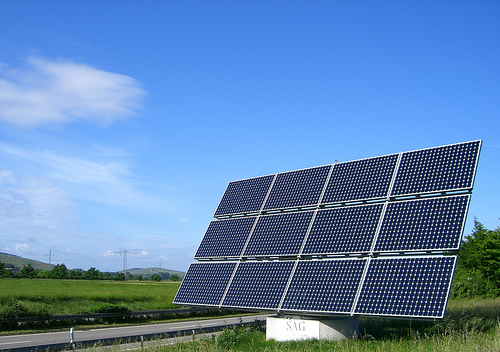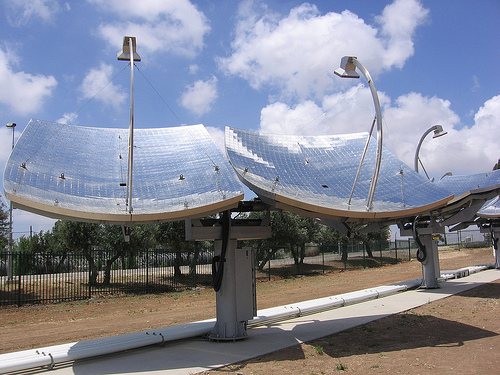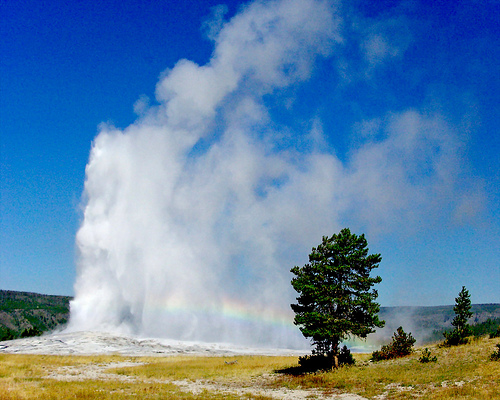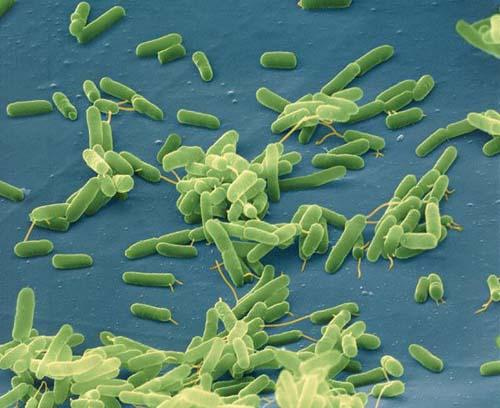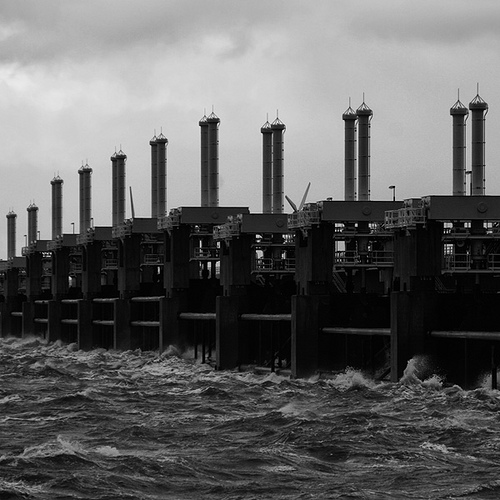This page gives an overview of candidates for the world's energy in the future along with their advantages, disadvantages, and likelihood of working.
- Solar
- Photovoltaic Systems
Description:
Photovoltaic cells convert the sun's energy directly into electricity. Silicon-based systems are fairly efficient, but expensive and rigid. Organic-based solar cells are cheaper and flexible, but are not very efficient. Half the cost of solar cell home units is the installation.
Advantages:- Pollution free during operation
- Cost is getting competitive with fossil fuels
Disadvantages:- Only works when the sun shines
- Creating the solar cells takes significant energy that is only paid back after 1-5 years of operation
- Deployment takes a large surface area
- Uses many rare elements which may prevent mass production
- The costs of PV panels is rapidly falling, but 60% of the cost is installation and associated electronics
- In the US, the lack of a national standard for installation drives up the price
Current Cost: 5-10 cents/KWhFuture:Near term: solar cells will continue to be a growing market as competition, research, and standardization brings cost down.
Long term (10 yrs): bright. - Photooxidation of Water
Description:
The splitting of water by light into hydrogen and oxygen is called Photooxidation or Photo-electrochemical (PEC). Water filled panels with the right catalyst can use the sun's rays to create hydrogen and oxygen gas from water. This is still a very new technology for commercial use. The best efficiency is 42%.
Advantages:- Clean, carbon-neutral renewable energy
- Unlike photvoltiac systems, photooxidation can store energy as hydrogen gas and generate electricity later on demand.
Disadvantages:- Only works when the sun shines
- Hydrogen is a little tricky to store, it seeps into the surrounding material and tends to make it brittle.
- After production of the hydrogen gas another step is needed to create electricity either by burning in an engine or turbine, or in a fuel cell.
- Until recently PEC needed expensive catalysts.
Current Cost: ???Future: bright
Long term (20 yrs): bright. - Concentrating Solar Power (CSP)
Description:
Concentrating Solar systems focus sunlight onto a working fluid. Today CSP has three forms. Solar Towers use arrays of mirrors to focus sunlight onto a central tower that contains a fluid that is heated, then the heat is transferred to water and used to run a steam turbine. Parabolic troughs focus sunlight on a tube of liquid like oil that is then used to ultimately turn a steam turbine. Stirling systems use mirrors to focus sunlight to the hot side of a Stirling engine.
Advantages:- No green house gases emitted.
- Once built, no fuel costs to keep running.
Disadvantages:- Expensive capital costs upfront
- Maintenance can be expensive
- Only works when the sun shines, although some systems can store heat in molten salt for use overnight.
- Photovoltaic solar panels are so inexpensive now, that concentrated solar is no longer economical.
Current Cost: 15-20 cents/KWH.Future: bleak.
Long term (20 yrs): bleak. - Ocean Thermal Energy Conversion
Details here.
- Solar chimneys
- Photovoltaic Systems
- Wind
Description:
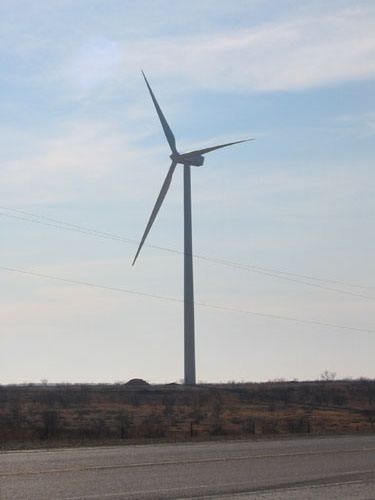
Wind energy is currently harvested from large windmills. The exciting aspect of wind power is that it is almost cost competitive with traditional forms of power generation. No one expects wind to provide all the power for a grid, but it is a nice supplement. Some of the disadvantages are being addresses with off-shore wind farms.
Advantages:- Renewable
- Operates with no pollution
- Operates with no production of green house gases
- Almost cost competitive with coal and gas
Disadvantages:- Intermittent, only works when the wind blows; most windmills operation at 25 percent of capacity
- Can be noisy and unsightly
- Cannot be depended on for peak load generation
- Can chop up birds and bats
- Capital intensive
- Best locations are often far from populated areas requiring the building of expensive power lines
Current Cost:3-5 cents/KWh for Utility Scale; 15 cents/KWh for rooftopFuture:Very bright. With better engineering the cost is dropping significantly every decade. - Geothermal
Description:
Geothermal uses the heat inside the earth to produce electricity. Typically this is done by pumping water into wells, letting the earth heat the water, and pumping the hot water back to the surface to be used to drive generators to produce electricity.
Advantages:- No fuel is needed.
- Electricity can be produced constantly, unlike wind and solar.
Disadvantages:- Expensive - although the fuel is free, the capital costs can be enormous.
- Only feasible where the earth's crust is thin
- Many dissolved salts and gases come out of solution when the pressure on the water is lowered. Arsenic may pollute the local vegetation. Gases like Hydrogen Sulfide can be released.
- May trigger earthquakes.
Current Cost: 7-11 cents/KWhFuture:
Long term (20 yrs):fairly good. - Biomass
- Traditional Ethanol and Cellulosic Ethanol
Description:
Ethanol is produced by fermenting crops like corn or switchgrass.
Advantages:- Renewable
- Ethanol has a fairly high energy density
- Can be blended with gasoline and used in automobiles
Disadvantages:- The current fermentation of corn does not produce much more energy, than it takes to make the corn. Switchgrass and other cellulosic ethanol can be much more efficient but need better enzymes to break down the cellulose
- The demand for corn based ethanol has driven up the price of food, fertilizer, and pesticides
- Ethanol cannot be transported in a pipeline since it collects water
- Ethanol has a lower energy density than gasoline
- Renewable?
One of the problems with all biomass is the question: "Is this process truly renewable?". Can we continually take biomass like cornstalks from a fields without depleting the soil? When the buffalo roamed the American heartland, they grazed the prairie, but returned dung and eventually on their death, the nutrients in their bones. So the process was neutral. When we harvest biomass do we need to replace those nutrients we take?
Current Cost:Future:short term: marginal
Long term (20 yrs): Fair. With the right bacteria all types of agricultural waste like corn husks and lawn trimmings could be converted to ethanol, but it will take some work to find or engineer the right bacteria. - Biodiesel
Description:
Biodiesel is produced by crushing plant material like soybeans and palms
Advantages:- Renewable
- Flexible - biodiesel can be made from a variety of plants
- Can be burned in current diesel engines with minor adjustments
Disadvantages:- Will drive up food prices
- Will take up a lot of land to grow the plants
- May harm wildlife, like butterflies
Current Cost: not competitive with conventional dieselFuture: Bright.
Long term (20 yrs): Bright. - Bacteria
Description:
Biology is a very exciting frontier for energy creation. We have not yet scratched the surface on what bacteria can do. Terminates have over 20 different bacterium in their gut to convert wood to energy. With a little selective breeding (or genetic engineering for the impatient), bacteria could convert waste into usable energy for us.
- Hydrogen Producing.
- Methane Producing
Methane is produced by letting bacteria digest organic material
- Direct Current
Some bacteria can create electricity directly.
- Burning
Coal-fired power plants could push their waste CO2 into tanks where bacteria remove the CO2 and produce biomass that can be burned in the power plant.
Advantages:- Clean and renewable
Disadvantages:- If some genetically engineered organisms escape into the wild the results are unpredictable.
Current Cost:Future: bright
Long term (20 yrs): Very bright
- Traditional Ethanol and Cellulosic Ethanol
- Ocean
- Wave
Description:
A few types of designs exist for harnessing the energy of waves. Some are buoys in the ocean which generate electricity from being pushed up and down by the waves. Another is a long snake-like series of tubes that are lifted up and down by the waves. A third type is on the seashore and rely on waves to push air into a pipe which drives a wind-turbine. Another is a clamshell device whose shell is pushed back and forward by waves forcing a fluid to a turbine on shore.
Advantages:- Clean and renewable
- Sixty percent of the world's population lives within 40 miles of a coast
- Waves are more reliable than the wind and can be predicted more accurately
Disadvantages:- Costly, more expensive than wind
- Saltwater is a very corrosive environment for equipment
Current Cost:Future:
Long term (20 yrs):. - Tidal
Description:
Tidal power captures the energy of water rising and falling with tides. This can be done with underwater turbines or by damming a bay.
Advantages:- Clean and renewable
- Unlike wind and waves, the tides are predictable
Disadvantages:- Fairly expensive
- Seawater is highly corrosive
- Difference in tides is not very high so power generation is not as efficient as in tall dams
- Timing of tides does not correlate with peak demand
- May effect shipping
- May prevent dispersement of industrial wastes
Current Cost:Future:
Long term (20 yrs):. - Thermal energy
Description:
In the tropics the top layer of water is hotter than the lower layers. The temperature difference drives the energy production. In ocean thermal energy production the hot water is used to turn a turbine by boiling a liquid with a low boiling temperature and then condensing the gas back to a liquid with water piped from the bottom of the ocean.
Advantages:- Clean and renewable
- Very predictable
- No fuel needed
Disadvantages:- Fairly expensive in capital cost
Current Cost:Future:
Long term (20 yrs):.
- Wave
- Non-Traditional Hydrocarbons
- Shale Oil
The Bureau of Land Management estimates the US oil shale reserves at 800 billion barrels of oil, three times the proven oil reserves of Saudi Arabia. "Shale Oil" is not really shale or oil, but kerogen, an uncooked oil, embedded in a hard rock called marl. The kerogen can be heated to resemble oil. The big problem is getting it from ground. Shell Oil is running a pilot plant in Colorado using heaters to loosen the oil and gas from the rock. The test plant gets twice as much energy than it consumes heating the rock.
- Tight Oil
This is traditional petroleum that is trapped in tight formations. With new fracking technology the oil can be released from its location.
- Coal To Liquids (CTL)
Description:Synthetic gasoline and diesel can be produced from coal with processes like Fischer-Tropsch. Long term this will provide the ceiling for oil prices. The Germans and Japanese used this process in WWII.Advantages:
- The U.S. and China have vast coal reserves.
Oil is 2 percent of the US's energy reserves, 3 percent is in gas, and 95 percent is in coal. Just Illinois' coal resources have more energy than all of Saudi Arabia's and Kuwait's oil reserves combined.
- Less polluting than burning coal.
- Current diesel engines can burn it.
Disadvantages:- If oil goes below $30, synthetic gasoline is too expensive.
- Strip mines aren't pretty
- The U.S. and China have vast coal reserves.
- Gas To Liquids (CTL)
Description:Synthetic gasoline and diesel can be produced from natural gas with processes like Fischer-Tropsch using carbon monoxide and hydrogen gas.Advantages:
- The U.S. has a lot of natural gas, especially with the new shale gas coming on line.
- The process has already been proven to work at the Royal Dutch Shell plant in Qatar.
Once the plant is built diesel can be produced for $1.57 a gallon.
Disadvantages:- Industrial plants to convert natural gas to liquid fuels are expensive.
- Tar sands
Description:
Tar sands are thick hydrocarbons dispersed in sandy soil. They cannot be pumped directly like oil, but must be processed in other ways like digging the soil, transporting it to a refinery, and cooking the hydrocarbons into something useful. Canada is producing 1 million barrels of oil per day from tar sands and can still scale up the process.
Advantages:- Located in Canada
- Provides a reliable source of petroleum
Disadvantages:- Causes environmental damage
- Produces more greenhouse gases than normal refining of oil
- Uses a lot of water
Current Cost:Future:
Long term (20 yrs):. - Methane Hydrates
Description:
Methane gas trapped in ice chunks underneath our oceans and land is called Methane Hydrates. The pressure of the oceans or land above it keep the methane trapped in ice. If you remove a chunk of the ice and place it in our atmosphere it will crackle as the gas escapes the ice. The ice can contain 180 times its volume in methane gas. You can hold a match to it and set it on fire.
Advantages:- We have a plentiful supply.
"There's more energy potential locked up in methane hydrate formations across the world than in all other fossil energy resources combined," - Brad Tomer, director of the Department of Energy's Strategic Center for Natural Gas and Oil.
- The supply is close to North America.
Just of the coast of the Carolinas alone is a field of methane hydrates equal to over a hundred times our annual use of natural gas.
Disadvantages:- Although two methods of extraction: depressuration and hot water injection, have been proven, we don't have an economical method of producing the methane.
- Tsunamis created by a collapse of the sea floor could be a possible side effect or removing the gas.
Current Cost:UnknownFuture:good
Long term (20 yrs): good. - We have a plentiful supply.
- Shale Oil
- Salinity Gradient Power
Description:Salinity Gradient Power is based on the pressure of fresh water going through a membrane to saltwater. Pilot plants have been built to test this concept.Advantages: No fuel needed, no carbon emissions, clean power.Disadvantages: cost is unknown.Current Cost:UnknownFuture: unknown
- Thermoelectric
Description:Thermoelectric materials make electricity from a temperature differential. Heat one end of a thermoelectric bar and electrons flow to the other side. This could be very useful in capturing the waste heat from a car engine to recharge the battery or run the headlights. Some satellites use Radioactive Thermoelectric Generators ("RTG"s) for power. A radioactive source like plutonium create the heat to drive the thermoelectric device.Advantages:Temperature differences exist all around us.Disadvantages:Efficiency is very low.Current Cost:Too highFuture:Niche player
- Nuclear
- Fission
- Traditional Fission from Uranium
Description:
Splitting the Uranium atom releases energy that is used to create steam to turn electrical generators.
Advantages:- No green house gases created
- We have a plentiful supply of Uranium from reliable sources.
- Reactors produce constant energy with little down time.
Disadvantages:- Possibility of an accident with massive loss of life and property.
- Disposal of waste is still a concern. Waste is toxic for millennia.
- Material for weapons can be diverted from a reactor.
- Reactors have an initial high capital cost.
Current Cost:5-7 cents per KWHFuture:mirky, with the recent accidents and natural gas being so cheap traditional nuclear is a hard sell - Pebble-Bed
- Traditional Fission from Uranium
- Fusion
- Traditional Magnetically Confined Plasma (Tokamak) Description:
Plasma is superheated in a donut shaped 'bottle' and forced to undergo fusion.
Advantages:- Little radioactive waste
- Theoretically very promising
Disadvantages:- This technology has always been '20 years' from deployment.
- Lots of technical hurdles to overcome
Current Cost: N/AFuture: 20 years away
Long term (20 yrs): fairly good. - Laser Ignition. Example is Sandia's Z machine.
Description:
Laser Ignition uses many lasers to compress a pellet of deuterium and tritium to produce fusion.
Advantages:- Little radioactive waste
- Fuel is plentiful and cheap
Disadvantages:- A power plant using this technology is still 20 years away.
Current Cost: N/AFuture: lots of details to work out
Long term (20 yrs): very bright. - Thorium
Thorium sits two elements away from Uranium in the periodic table and can be used to produce electricity like Uranium, but without many of the drawbacks. Thorium reactors cannot maintain their own fission, so meltdown accidents are not possible. Thorium is 500 times more plentiful than Uranium. The major issue is how to kick-start and maintain a thorium reactor.
- Inertial Electrostatic Confinement (IEC) video.
- Levitated Dipole.
- Bubble
- Cold
- Crystal
- Polywell
- Traditional Magnetically Confined Plasma (Tokamak)
- Fission
- Unusual and Highly Speculative
- Capturing lightning strikes
- Man-made tornadoes.
- Free energy or vacuum based systems
Energy Storage Solutions
Many of the renewable energy system need a storage mechanism to be really useful in the grid. Below are some methods to store energy:
- Pumped-storage hydroelectricity (PSH)
Pump water uphill to a reservoir when energy is plentiful and running it down through a turbine when energy is needed. Disadvantages: Few geographic regions have two suitable reservoirs at different heights. Advantages: Fairly efficient and technology is known. Efficiency: 70-75%.
- Flow batteries
Liquids are moved between large storage tanks and reacted in a smaller container.
- Sodium Sulfur (NaS) Batteries
These use liquid sulfur and salt to store electricity. Advantages: Well known technology, used in Japan for years for peak power in the grid.
- Lithium-ion Batteries
Lithium-ion batteries charge faster and have a higher energy density than lead-acid batteries.
- Lead Acid Batteries
Invented in 1859 by Gaston Plante, lead acid batteries have been the workhorse of energy storage. Advantages: Well understood, stable, reasonably priced. Disadvantages: Low energy density compared to other technologies; the lead must be carefully recycled.
- Compressed Air Energy Storage (CAES)
Energy can be stored as compressed air in caverns, aquifers, or depleted natural gas wells. When needed the compressed air is directed to turbines to generate electricity. One problem is that the decompressed gas gets really cold and can freeze any moisture creating ice that damages turbine blades. Another issue is during compression the gas get hot. Efficiency: 42%.
- Molten Salt
Salt can store excess heat from solar thermal collectors and be used at night to generate steam to make electricity. Disadvantages: The salt is corrosive and it's heat must be used within days.
- Hydrogen gas
Spare electricity is used to split water into hydrogen and oxygen gases. When electricity is needed, the hydrogen is used to create electricity. Currently, ahum,.. the process is inefficient, but companies like ITM are reducing the cost.
- Flywheels
Flywheels are disks that spin very quickly in a vacuum. When energy is available the speed is increased, when energy is needed, the flywheel is tapped to generate electricity. Advantages: well proven technology; little maintenance needed. Disadvantages: price is not sufficiently better than batteries.
- Supercapacitors
Devices similar to batteries, but they store energy electrically not chemically in a capacitor. Disadvantages: Expensive. Advantages: Have an extremely long life - they can under tens of thousands of recharge cycles without degrading.
- Fuel Cells
Fuel cells convert a fuel like hydrogen to electricity without burning using a membrane. When electricity is plentiful, hydrogen could be created by electrolysis. Advantages: Little pollution; fast recharge. Disadvantages: The catalysts involved are quite expensive for the fuel cell.
- Advanced Rail Energy Storage (ARES)
New untested method is using heavily weighted railroad cars that are pulled up a hill when electricity is plentiful and allowed to roll downhill when power is needed, driving a generator. Estimated efficiency is 85%.
- Future: Superconducting coils
Once we get our room temperature superconductors (right after our flying cars) we can store energy in rings of the material.
Parting Thought:
The frustrating thing about providing energy is that it is all around us like the air we breath, but harvesting the power is elusive. Waves constantly pound our seacoasts, lightning dissipates vast quantities of electricity, sunlight falls gently on our planet, the wind blows ceaselessly, vast temperature differential exists just miles below our feet, but alas, all goes unharnessed. Hopefully in the future one our children will take energy production like we do clean water - just turn on the spigot and it's there.
Miscellaneous Info:
- Transmission losses for electricity are 3% per 1000 kilometers.
- The United States spends 700 Billion dollars each year on imported oil.
- As of 2007 the world's population consumes about 15 terawatts of power. (A terawatt is 1,000 gigawatts. (A large coal-fired power station could produce about a gigawatt). This is about 6 trillion dollars of energy.
- 10,000 deaths occur each year from mining coal.
- Electricity from coal-fired power plants costs 3-5 cents/kilowatt hour.
- The cost of crude oil is 70 percent the cost of gasoline.
- Motorcycles, although more fuel efficient, produce ten times the pollution of cars per mile.
- A gas-powered lawn mower while it's running pollutes the same as eleven cars.
- One gallon of gasoline is equivalent to 12.7 KWH or 3.53 MJ (million Joules).
- A lead-acid battery has a specific energy of 32 watt-hours/kg. A lithium-ion battery has 120 watt-hours per kilogram.
- The United States produces 10% of the world's oil and consumes 24%.
- In 2006 the United States consumed 20.7 million barrels a day (MMdb) of crude oil and produced 5.1 MMdbof that
leaving 13.7 MMdb to be imported.
During 2006, our five biggest suppliers of crude oil and petroleum products were:
- Canada (17.2%)
- Mexico (12.4%)
- Saudi Arabia (10.7%)
- Venezuela (10.4%)
- Nigeria (8.1%)
- Making a new aluminum can from a recycled one requires five percent of the energy it would take to use raw materials.
- 22 percent of the electricity used in the US is for lighting.
- Gasoline contains 45 megajoules per kilogram, lithium ion batteries around 0.6 MJ/kg.
- Energy is an $8 trillion per year industry.
- An efficient electric vehicle can get between 3 to 5 miles per KWhr.
